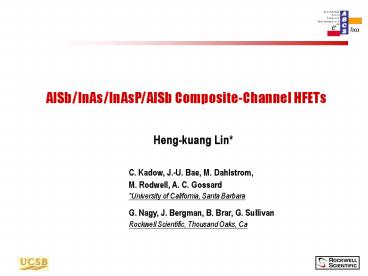ABCs: InAs/AlSb HEMT development - PowerPoint PPT Presentation
Title:
ABCs: InAs/AlSb HEMT development
Description:
Heng-kuang Lin* C. Kadow, J.-U. Bae, M. Dahlstrom, M. Rodwell, A. C. Gossard *University of California, Santa Barbara G. Nagy, J. Bergman, B. Brar, G. Sullivan – PowerPoint PPT presentation
Number of Views:198
Avg rating:3.0/5.0
Title: ABCs: InAs/AlSb HEMT development
1
AlSb/InAs/InAsP/AlSb Composite-Channel HFETs
Heng-kuang Lin
C. Kadow, J.-U. Bae, M. Dahlstrom, M. Rodwell,
A. C. Gossard University of California, Santa
Barbara G. Nagy, J. Bergman, B. Brar, G.
Sullivan Rockwell Scientific, Thousand Oaks, Ca
2
AlSb/InAs/AlSb HFETs
- Disadvantages
- Small Eg (InAs) low Vbr
- High kink current, high Ig
- Degraded noise performance
- Advantages
- High m , vsat
- ft , fmax 162 GHz
- ( Lg 0.25 mm )
J. Bergman, et al., IPRM, 2003.
3
Our Approach for Breakdown Composite Channel
- Motivation
- ABCS HFETs need higher
- Vbr.
- Approach Composite channel
- Electrons move in high-
- mobility material at low
- fields ? InAs.
- Electrons move in high-Vbr , high-vsat material
at high - fields
- ? What material ?
High field region
Low field region
4
Why InAsP as subchannel ?
5
Characterization of Composite Channel - I
First step Characterize InAs channels
InAs / InAsP 2 DEG
Energy band diagram / Carrier profile
6
Characterization of Composite Channel - II
R-T Hall Ns vs P ratio
R-T Hall Mobility vs P ratio
- 430 ºC Optimal InAsP growth temperature
- m gt 20,000 cm2/ V-s for P ratios up to 0.4
7
Characterization of Composite Channel - III
Second step Characterize InAsP subchannels
Energy band diagram / Carrier profile
R-T Hall Mobility Ns vs P ratio
?
X
- 430 ºC is again optimal InAsP growth
temperature - m gt 7,000 cm2/ V-s in InAs0.8P0.2 subchannels
8
Carrier Transfer vs Impact Ionization
e
1.
Vgs
2.
y direction
y
x
h
?
?
x direction
1. Transfers to InAsP 2. Impact-ionizes
Wave functions
e
Ey2.1X105 V/cm
Ey2. 3X105 V/cm
?EEg(InAs)
Ec(InAsP)
e
h
Ec(InAsP)
Ec(InAs)
Ec(InAs)
InAs
InAsP
Surface
substrate
Ev(InAs)
Ev(InAsP)
Ey, max, transfer 2.2X105 V/cm
9
Our Approach Introduction of a Doping Dipole
Dipole P-doping (Be) plus N-doping
(Te)
- Advantages
- Reduced external bias to
- reach Ey, max, transfer
- Easier electron transfer
- Improve breakdown
- 2. Hole barrier in buffer
- Prevents hole accumulation
- Reduces kink current
10
Suggested Composite-Channel Device Layer
Structure
As-grown material m 14,500 cm2/ V-s (R-T
Hall) Ns1.7x1012
cm-2
3.5 strain
Si 1x1019 cm-3
1.5x1012 cm-2
InSb-like interfaces
InAs Channel 10 nm
InAsP Subchannel 10 nm
Digital alloy 20 P
0.9x1012 cm-2
7 strain, dislocations, buffer
11
Standard Processing Flow
1) Ohmic contacts
1)
2)
2) Mesa isolation by dry etch
TLM Rsh 220 ?/square Rc 0.065 ?-mm
3) Optical recessed gate
4)
3)
4) Metal 1
12
Comparison between Single and Composite Channel
DC Characteristics - I
HFETs 0.7x40 ?m2 Blue composite channel Red
single channel
No impact ionization peaks
gds (Red) gds (Blue) 14 1 ( Vgs - 0.2 V,
Vds 0.6 V )
13
Comparison between Single and Composite Channel
DC Characteristics - II
HFETs 0.7x40 ?m2 Blue composite channel Red
single channel
14
RF Performance for Composite Channel
Max fT for single channel
Max fT for composite channel
- fT Lg 32 GHz-µm composite channel
- fT Lg 44 GHz-µm single channel
Slight degradation on RF performance
15
Conclusion
Growth - Develop materials for InAs/InAsP
composite-channel HFETs ? (InAs) gt 20,000
cm2/ V-s for 40P in InAsP subchannels Device
performance DC - Increased Vbr (0.5V to
0.8V) - Reduced kink currents ( gds 141) -
Suppressed impact ionization in Ig RF -
fT,max 46 GHz, fmax,max 61 GHz (0.7-µm gate)
- fT Lg degrades from 44 to 32 GHz-µm
InAs/InAsP composite-channel HFETs are
a promising enhancement to InAs
single-channel HFETs.































